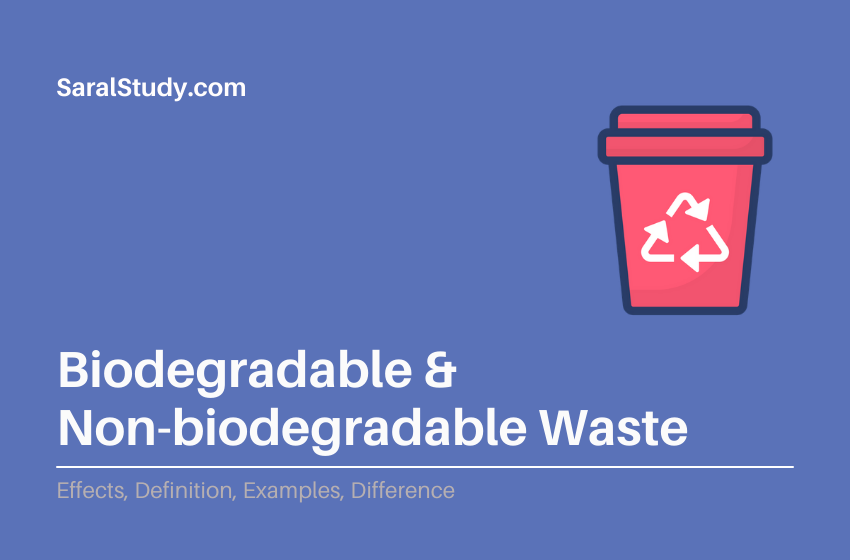Biodegradable items are those that degrade or break down naturally. Non-biodegradable items are those that do not degrade easily. These terms define the ability of the substances which are degradable or not. Substances like plants, animals, fruits, flowers, vegetables come under biodegradable substances. And Rubber, plastic, chemicals, paint plastic falls under the classification of non-biodegradable items.
The environment in which we live is surrounded by these two things only even the substances we use in daily life can be biodegradable or non-biodegradable. It is usually seen that non-biodegradable substances are manufactured and do not occur naturally, therefore their degradation is also not possible. However, biodegradable items easily decompose in nature by agents like water, soil, sunlight, microorganisms, etc. And it directly or indirectly is profitable to the environment.
Biodegradable Waste – Definition
Biodegradable substances are those, which degrade or break down naturally. In other words, their decomposition happens with the help of natural agents like sunlight, microorganisms, water, ozone, and more which turns them into organic manure.
Thus, Biodegradable substances are non-toxic to the environment including only natural materials. They change into simpler units and then we use them as fertilizers, manure, compost, biogas, and many more. Therefore, this makes them eco-friendly.
Nowadays, importance is given to using biodegradable and eco-friendly items as much as possible to reduce the level of pollution and substance responsible for it. This will also reduce the pollution up to some level, which is becoming one of the major dilemmas worldwide and is dangerous to every living being.
Biodegradable Waste – Identifying
It is usually of plant, animal, or mineral origin. It can be easily disposed of by the act of microorganisms or animals. It can be broken down into base elements and is easily absorbed by the environment without damaging it.
Below are the 10 examples of biodegradable materials:
- Food waste
- Paper
- Human feces
- Animal Manure
- Human Cadaver
- Deceased animals
- Dead plants
- Cotton
- Toilet paper
- Pencil
Non-biodegradable Waste – Definition
Non-biodegradable substances are items that do not degrade easily. As they are manufactured and do not occur naturally, degradation is impossible with certain products. Hence, when they stay in the ecosystem for a long period and do not decompose, they harm our environment.
The disadvantage of Non-biodegradable substances is that in place of returning to the environment, they convert into solid waste which acts as a great threat to the environment and health. This is eco-friendly and we must avoid using it at all costs.
Many steps are taken these days, concerning the use of non-biodegradable substances. The three ‘R’ concepts which say Reduce-Recycle -Reuse is in trend, which explains the use of the non-biodegradable materials. As we already discussed, these substances do not decompose or dissolve easily so can be recycled and reused. And one can aid in reducing this waste by throwing the plastics and poly bags in the garbage. This can be placed in the recycling bags to use again.
Non-biodegradable Waste – Identifying
It is not of plant or animal source or is of plant and animal origin but is prepared and modified to change its basic natural composition. And hence cannot be broken down into smaller products by the action of living things such as animals or microorganisms.
Below are the 12 examples of non-biodegradable materials:
- Rubber
- Batteries
- Glass
- appliances
- Plastic bottles
- Metal
- Nuclear waste
- Synthetic fibers
- Ceramics
- Cans
- Artificial rubber
- Styrofoam
Differences between Biodegradable and Non-biodegradable Waste
Basis For Comparison | Biodegradable Substances | Non-Biodegradable Substances |
Definition | The wastes that decompose naturally in the environment and are regarded as safe for the environment are called biodegradable substances. | Such wastes which do not decompose naturally in the environment and cause pollution and are also harmful to the living being are called the non-biodegradable substances. |
Examples | Dead plants and animals, dug, fruits, vegetables, flowers, paper, etc. | Chemicals, paints, plastic, rubber, toxic, plastic, metals, etc. |
Rate of decomposition | The rate of decomposition of biodegradable substances is High. | The rate of decomposition of non-biodegradable substances is Slow. |
Decomposed by | Fungi, bacteria, and other living organisms have the ability to decompose the material into the soil. | These items do not degrade easily or by the action of natural agents. |
Use | After degradation, they can be used to produce biogas, manure, fertilizers, and compost. | Their degradation rate is slow and the separation and recycling are not easy and costly too. |
Effect | Biodegradable substances are not harmful to the environment. | They are harmful to the environment. |
Effects of Wastes Material on Environment
The main harmful effects of wastes material on environment are:
Harmful Effects of Biodegradable Wastes
Biodegradable wastes pollute the environment only when they are in abundance in the environment. Through the following ways they can affect the environment:
- They produce a huge quantity of microbial flora around the wastes. These microbes can generate several communicable diseases in humans, animals, and plants.
- Due to the release of certain gases these wastes generate bad odor on burning as it releases certain gases which contribute to greenhouse gas.
- Amounts of such biodegradable wastes are the breeding terrains for carriers and vectors like mosquitoes and rats which grow several communicable diseases.
- Abundant biodegradable waste in the water supply can consume its oxygen.
Harmful Effects of Non-Biodegradable Wastes
Some of the harmful effects of non-biodegradable waste in the environment are as follows:
- Unnecessary use of non-biodegradable wastes like chemical pesticides (D.D.T) and fertilizers make the soil acidic or alkaline thereby affecting the soil fertility.
- It can also affect the aquatic life by these substances being washed away from the fields into the nearby water bodies and further promoting algal blooms. This aspect is termed Eutrophication.
- Toxic substances like D.D.T when entering any food chain, being non-biodegradable, keep on expanding progressively at every trophic level. Since humans hold the leading trophic level in any food chain, the maximum intensity of these chemicals can be determined in human bodies. This phenomenon is termed biological magnification.
- Also known as foamed polystyrene, Styrofoam is a non-biodegradable substance that can create environmental problems when it is littered and unnecessary in the environment. For example, styrene, a neurotoxin at high dosages, can drain out of polystyrene materials if temperatures increase.
Conclusion
When discussing the environment biodegradable and non-biodegradable terms are often used as both are linked with it. Therefore, the use of non-biodegradable substances should be reduced to a remarkable level as they are majorly contributing to the rising of pollution. As with the reduction in the use of non-biodegradable waste, there can be a decline in the hazardous substances from the environment making it pollution free for all living beings.
While the use of biodegradable substances should be raised, regarding environmental issues. Thus a lot of measures are being taken up by the government and different organizations to encourage the use of biodegradable substances and avoid non-biodegradable materials. Further, the best way to save the environment is to adopt a recycle and reuse method from getting more damaged. As non-biodegradable wastes do not decompose or easily dissolve, so it is better to recycle and reuse them for reducing this kind of waste. Other than that, one can try to go green by only using biodegradable materials.
Frequently Asked Questions
Q1. What do you understand by Non – Biodegradable?
Ans. Non – Biodegradable substances are those which does not easily decompose by any natural factors or by any biological processes. Further, most of the inorganic, plastic, and artificial waste is examples of non-biodegradable.
Q2. Name some biodegradable products?
Ans. One uses more biodegradable products than they are consciously aware of. Thus some of these items are coffee grounds and food scraps, paper towels, toilet paper, newspapers, junk mail, paper plates and cups, clothing, towels, etc.
Q3. Why are plastic bags considered non-biodegradable?
Ans. Plastic bags are not considered environmentally friendly because they do not decompose easily as decomposer organisms are not able to decompose plastic and make it into a simpler substance which makes it a non-biodegradable product.
Q4. How do you dispose of non-biodegradable waste?
Ans. The best and most effective way to dispose of non-biodegradable waste is recycling. As it not only helps in the re-use of the material but also reduces the need to produce more non-biodegradable products.
Q5. Why is Biodegradable ideal for the environment?
Ans. Biodegradable substances are great for the environment because they break down into natural chemicals, natural gases, and organic materials. Biodegradation is a method wherein microorganisms existing in the water, soil, and air act upon an organic or inorganic material and decompose it.
Q6. What is an Eco-Friendly environment?
Ans. An eco-friendly environment is one that doesn’t feign any immediate or long-term danger to natural resources such as air, water, and soil. It also signifies a living condition that doesn’t result in any sort of pollution or wastage of exhaustible energy resources.





